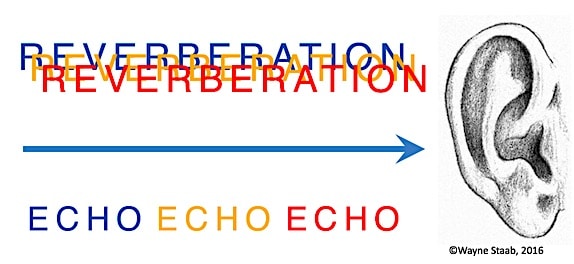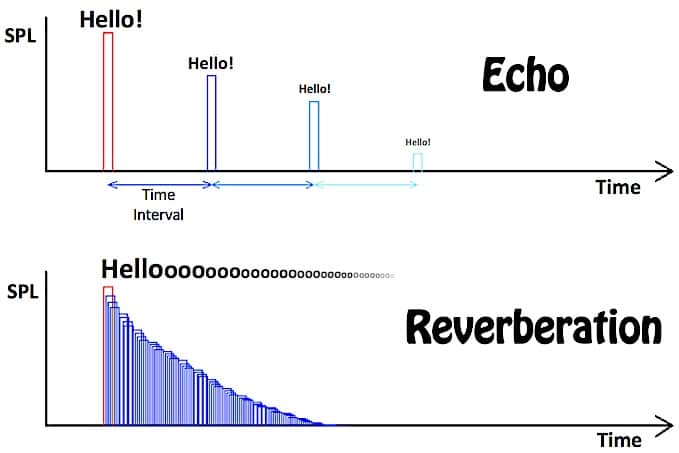Even in Hearing Aids, Echo Sometimes Has the Last Word

A recent post reflected on how an echo is created by an acoustic delay, and even touched on mythology as an interesting, but non-scientific, explanation for its existence. The article suggested that the delay that causes the echo could even have implications for hearing aids. How can this be?
Echo or Reverberation?
In acoustics, an echo is a sound reflection, arriving at the listener some time after the direct sound. Ordinarily, echo is a sound phenomenon related to an outdoor environment. It is simply a slightly delayed repetition of a sound.

Figure 1. In reverberation, a listener hears sound from all quarters with various delays.
However, when indoors, sound reflections are so numerous they end up being merged with the original sound. As a result, when so many reflections arrive at a listener that they cannot be distinguished from each other (Figure 1), the proper term is reverberation.
The inability to hear the distinct repetitions is what distinguishes reverberation from multiple echoes. The difference between echo and reverberation is diagrammed nicely in Figure 2. If the time delay is quite long, the sound will be perceived as a series of an initial (one), and then some additional, discrete, repeated sounds (echo). The echo occurs when sound is reflected off a distant object/surface – distant enough so the reflected time delay is long enough for the reflections to be perceived as repeats.
If the reflecting object/surface is short in distance, the sound will also be reflected, but the time delay of the reflected sound is so short that the perceived sound is diagrammed as the initial sound with a “tail”, that fades in time as well. This kind of echo is referred to as reverberation.
The inaudibility of the distinct repetitions of the initial sound is what distinguishes reverberation from multiple echoes.

Figure 2. Illustrative representation of the difference between echo and reverberation. The inability to hear the distinct repetitions is what distinguishes reverberation from multiple echoes.
Does a Hearing Aid Have a Sound Delay?
Digital hearing aids have a delay, which is the time that it takes to sample the audio input, convert it to digital representation, perform its signal processing, and then convert it to an audio signal for delivery to the ear. The time involved from the initial stimulus reception until it is processed and delivered to the hearing aid speaker/receiver is called Group Delay, or Envelope Delay, and it is possible for this delay to be perceived as an echo in the sound heard by a hearing aid wearer listening to his/her own voice. This echo is due to a combination of{{1}}[[1]]Agnew, J. and Thornton, J. (2000). Just noticeable and objectionable group delays in digital hearing aids. J Am Acad Audiol, 11, 330-336[[1]]:
- Unprocessed sound received at the ear through head and air pathways, and
- Delayed sound reaching the eardrum through the hearing aid.
This activity is in contrast to an analog hearing aid where there is essentially immediate and continuous transduction from audio to electrical, and then back to audio. As a result, analog hearing aids have negligible group delay.
But, because digital hearing aids constitute essentially all of the hearing aids sold, this discussion is reserved for digital hearing aids only.
How Long Does This DSP Transfer of Information Take?
Delays of up to several hundred milliseconds (msec.) can be created in DSP (digital signal processing) hearing aids, depending on the particular architecture and algorithms that may be used to achieve the desired signal processing (Agnew and Thornton, 2000).
Next Week’s Post – Is this delay noticeable in digital hearing aids, and if so, so what?






